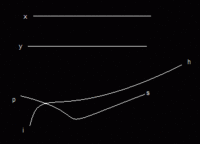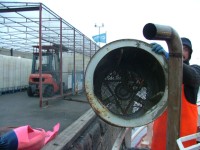Non-Euclidean Geometry
“Be square.”
Background[edit]
Non-Euclidean geometry is essentially a not important branch of geometry that does not involve Euclidean geometry. In the latter case, it was Lord Knonn Euclid (in his 1707 treatise on line theory 'Ecce Canis Non Secitur Lepos') where he proposed that parallel lines never intersect in space. By contrast, non-Euclidean lines may meet, often frequently, and don't care who knows about it.
History[edit]
Expanding this further, it was mathematician and one time Olympic underwater balloonist (free-style) Francis Not-Lucid (1827 - 1826) who presented to the Parisian Society of Reactionary and Cautious Scientists (Le Societe de Non Merci) his paper on shape theory of 1825, 'Squares that meet in space: A quantum perspective'. The audience was so disturbed by what he proposed that the ensuing riot through the streets of Paris lasted for 2 days and threatened to bring the down the government of Phillippe de Tanque and the Citrons (later to record on the Motown label as Phil Cockell and the Mussels). Central to his hypothesis was the notion that 'anti-parallel co-ordinates of a non-Cartesian quad-sphere are incidental to the tangent of interstitial dark matter and sub-quanta', specifically: "C'est non matter".
Euclid's 5th postulate stated as: "If a straight line falls on two straight lines in such a manner that the interior angles on the same side are together less than two right angles, then the straight lines, if produced indefinitely, meet on that side on which are the angles less than the two right angles." No one could contradict what Euclid was saying due to the fact that he had a very big head and people thought he was very smart. (it was later found out that Euclid had Hydrocephalus)
Around 1830 two Mathematicians claimed they found a way to prove Euclid’s postulate is wrong, Hungarian János Bolyai and Russian Nikolai Ivanovich Lobachevsky, both publishing trieatises on Hyperbolic Geometry. Both are still arguing to this day as to whom should get the credit but modern day mathematicians call it Bolyai-Lobachevskian geometry.While :Lobachevsky created a non-Euclidean geometry by negating the parallel postulate by simply saying “Euclid, you are wrong! Two parallel lines do meed when one of the hands that draws them get tired”, Bolyai worked out a geometry where both Euclidean and non-Euclidean Geometry can exist in one plain without killing each other. Bolyai ends his work by mentioning that it is not possible to decide whether Euclid can refrain himself from killing Lobachevsky for calling him a liar through mathematical reasoning alone, this is a task for the police.
When the mathematician Carl Friedrich Gauss read the work of János Bolyai's (Appendix) he screamed plaigarism, stating that he had arrived on the same conclusion on an earlier date but the dog ate his paper. While there is no evidence that Gauss had worked out the Non-Euclidean Geometry to an extent comparable to the works of Bolyai and Lobachevski, Gauss cannot be considered as the inventor of Non-Eucledian Geometry even though he claims that this is the case to this day.
Bernhard Riemann, in a famous lecture in 1854, founded the field of Riemannian geometry, discussing in particular the ideas now called manifolds, Riemannian metric, and curvature. He arrived to a conclussion that a plain is not flat but it is round like a spehere. Instead of throwing their pants at him, the people at the lecture said, “Hmm. Round…… Good Idea!”
Non-Euclidean Geometry Today[edit]
The controversy of non-Euclidean geometry continues even to this day, although gradual acceptance of the concept of a universe that contains objects that are not Euclidean do indeed exist. The mathematical proof of the existence of lines that are not of a Euclidean form (so-called non-straight or "curved" lines) being supplied by Terrence Wogan of the University of Knee in 1983. Indeed, a papal decree in 2003 finally saw the Catholic church accept that some lines may indeed be "curved" and did not necessarily "corrupt the glory of God and his creation". There remains non-Euclidean opponents however, largely in evangelist communities of the US midwest, headed by Rev Clit Bonkers of Fashistville, Kansas.
The development of non-Euclidean geometries proved very important to physics in the 20th century. Given the limitation of the speed of light, mass additions in zero gravity necessitate the use of hyperbolic geometry. Einstein's Theory of Relativity describes that Euclid can refrain himself from killing Lobachevsky for calling him a liar due to the fact that Euclid is Lobachevsky’s cousin twice removed. Non-Euclidean Geometry is also used by Spandex Manufacturers for calculating the maximum expansion of their products under eliptical stress
The Future[edit]
Renowned physicist Prof Ray Stubbs has predicted that by 2020 "curved" lines will be "such an everyday part of life that we will think nothing of them and be shocked to learn that once all things that were not Euclidean were regarded with fear and distrust. We will be wearing silver suits, time travel will be commonplace, and crows will not always take the quickest route from A to B."
their rule was undefines


